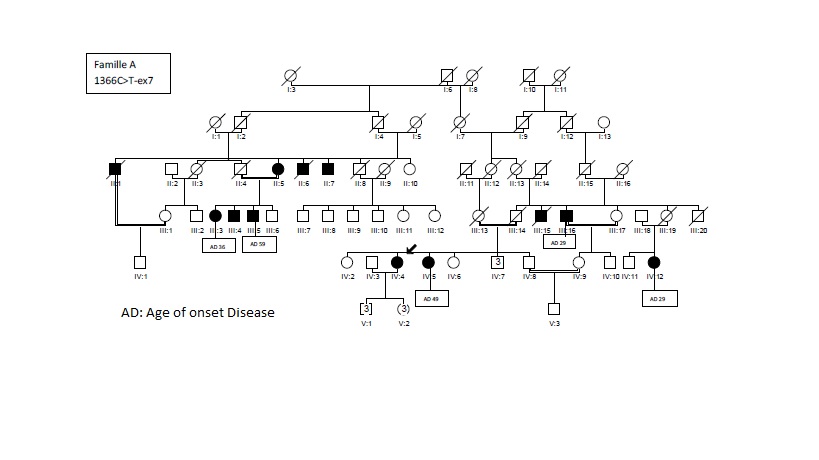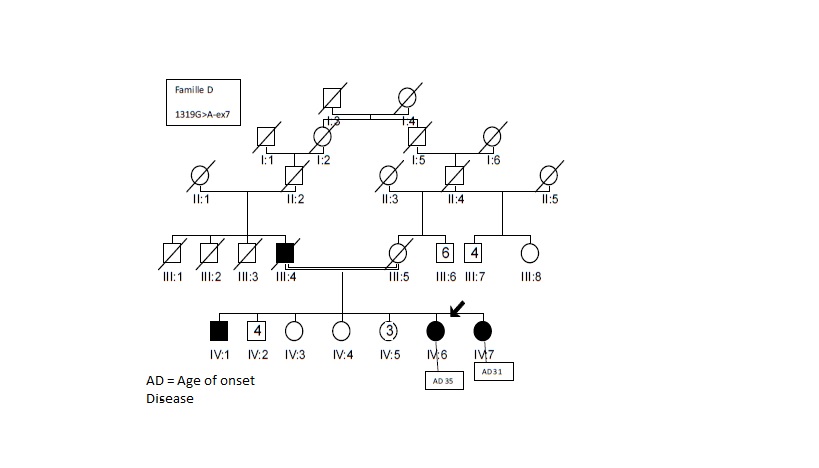Category: Parkinson's Disease: Genetics
Objective: To characterize the family history and clinical features of mutations of the PINK-1 gene in a cohort of Tunisian patients with Parkinson disease (P.D)
Background: PINK-1 mutation is one of the important causes of early-onset forms of autosomal recessive PD(1). some clinical features are specific including slow progression, good levodopa response, and preservation of cognitive function (2). The relevance of PINK-1 mutation to the etiology of PD has been poorly explored in North African Arab populations with a high degree of consanguinity.
Method: Ninety-nine patients from 72 Tunisian families were included.A neurological evaluation was performed in all patients.The LRRK2, PINK-1, PARKINE, SNCA, and DJ-1 genes were screened. Patients tested negative to LRRK 2, PARKINE, SNCA, and DJ-1 were considered as mutation-negative PD (MN-PD). Patients carrying PINK-1 were designed (M-PD). Clinical characteristics of the M-PD subgroup of patients were then compared to MN-PD subgroup.
Results: Forty-four patients, from 11 families carried the PINK-1 mutation were identified. Among them, 43 patients (97,72%) were mutated in homozygous and 1 (2,27%)in heterozygos for PINK-1 gene (with late-onset).Molecular analysis showed point mutation in exon 7 in 6 families, in exon1 in 3 families, in-frame deletion in exon1 (1 family) and a missens mutation on exon 7 in 1 family. Other family members of M-PD were affected in all cases.
The age of onset of PD was significantly lower in M-PD subgroup 36,9 (±13,6) years compared with MN-PD patients 50,3 (±14,2) years (p<10-3). The ages of onset varied between 13 and 40 years [Figures1,2].
Higher UPDRS (Part I,II, and III) were observed in MN-PD compared to M-PD (p<0,001; p=0,002 and p<0,001, respectively).However, freezing of gait and postural instability were significantly more observed in M-P (p=0,002, p=0,01, respectively). Mean L‐dopa‐equivalent doses was higher in MN-PD subgroup compared to M-PD (527 mg/day) (p<0,001). Impaired cognitive functions (score MMSE under 24) was significantly more observed in M-PD patients compared with MN-PD (p=0,032).
Conclusion: Our results confirm the slow clinical progression of PINK-1 mutated forms of PD.some motor features of PD patients carrying PINK-1 mutation:freezing of gate,postural instability and more altered cognitive function in our Tunisian M-PD series compared with MN-PD are distinct from those already described.
References: 1. Delamarre A, Meissner WG. Epidemiology, environmental risk factors and genetics of Parkinson’s disease. Presse Medicale Paris Fr 1983. mars 2017;46(2 Pt 1):175‑81. 2. Kim CY, Alcalay RN. Genetic Forms of Parkinson’s Disease. Semin Neurol. avr 2017;37(2):135‑46.
To cite this abstract in AMA style:
G. El Fessi, Z. Saied, F. Nebli, M. Zouari, S. Belal, S. Ben Sassi. Genotypic and phenotypic spectrum of PINK-1 associated parkinsonism in 44 mutation carriers from 11 Tunisian families [abstract]. Mov Disord. 2021; 36 (suppl 1). https://www.mdsabstracts.org/abstract/genotypic-and-phenotypic-spectrum-of-pink-1-associated-parkinsonism-in-44-mutation-carriers-from-11-tunisian-families/. Accessed January 6, 2026.« Back to MDS Virtual Congress 2021
MDS Abstracts - https://www.mdsabstracts.org/abstract/genotypic-and-phenotypic-spectrum-of-pink-1-associated-parkinsonism-in-44-mutation-carriers-from-11-tunisian-families/


